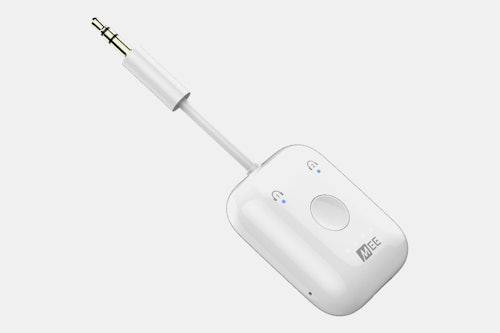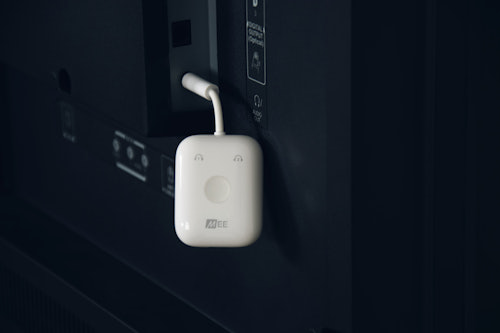Click to view our Accessibility Statement or contact us with accessibility-related questions
 VIEW 1 MORE
VIEW 1 MORE


MEE audio Connect Air Bluetooth Adapter
MEE audio Connect Air Bluetooth Adapter
bookmark_border
Where's the price?
To negotiate the best possible price for our customers, we agree to hide prices prior to logging in.
54 requests
Product Description
Many modern, high-end audio players and headphone amps have Bluetooth functionality built in—but many do not. The MEE Audio Connect Air allows you to expand the connectivity and functionality of your favorite audio player by adding Bluetooth 5.0 right from the 3.5-millimeter headphone jack Read More
Want to know something about this product or how to use it?
Ask the community!
Ask the community!
Sort by: Newest
keyboard_arrow_downBingley
12
Nov 18, 2021
Can this be used while it's charging? I would like to leave it permanently connected to a pre-out on our HT receiver, including to a power source, so that I never have to think about it again..

MEEaudio
7
Mee Audio
Sep 1, 2023
This device can definitely be used while charging, but if you don't have anything connected to it, it will turn off after a period of around 15 minutes. If you are looking for a device that will stay on continuously and wait for a connection, the regular non-portable version of this device (Connect model AF-T1) may be a better choice, as that does not have a battery saving feature. This will allow you to just set and forget.

Zinma
0
Nov 18, 2021
Will this work as an input for DACs? IE I want to use this with my DAC to pair it to my Chromecast TV, which is Bluetooth only. Cant see why it wouldn't work but Id rather see if anyone has tried this.

MEEaudio
7
Mee Audio
Sep 1, 2023
Unfortunately this device is solely a Bluetooth transmitter, not a Bluetooth receiver. That means it can be plugged into any 3.5mm audio *output* and transmit audio to a Bluetooth-enabled receiving device, such as a Bluetooth headphone or speaker.
A Bluetooth receiver would allow you to do the opposite - connect it to any audio *input*, and accept a Bluetooth signal from a Bluetooth-enabled transmitting device such as a phone, tablet, or in this case Chromecast.

SuperFlyEDSguy
62
Sep 4, 2023
You’re not going to want to (read: can’t) run a generic analog signal into your DAC anyways as your DAC is designed to take a digital signal and convert it into an analog output at a specific sample rate and bit depth depending on the quality of the digital input, e.g. 24/96 PCM. Usually, digital inputs will be in the form of USB, Digital Coax (generally with orange ends), and TOSLINK / Fiber / S/PIDF. Analog outputs will almost always be 1/8” (3.5mm) or 1/4” (6.35mm) for Unbalanced or Single Ended a/k/a “SE” connections (Balanced connections are beyond our scope, so I’m limiting it to this). Dual analog cables will usually come as RCA (tipped red and white) or separate Phono cables.
Now, I may be misunderstanding your question, but are you just looking to send the audio from the Chromecast TV to an input device that will connect to your speakers? If so, were you thinking that your DAC could be your input device?
Okay, the output, I’m of the understanding that all current Chomecast TV devices (circa 2019 and newer) are capable of transmitting Bluetooth audio. You just need to set it up in the appropriate menus. As this new Mee Audio Connector is also exclusively an output device, I guess you could use it on a legacy Chromecast TV without the builtin Bluetooth, but it sounds like you wouldn’t need it in if yours is relatively new.
So, onto the input, if you want to get that Bluetooth audio into the amp (that your DAC is connected to), I would simply find a Chi-Fi Bluetooth Preamp that could do the job! Something like this one will work just fine to receive that signal and output it to standard RCA cables for your chain. A model like that is just $50, you could find better, although I have a similar one and it actually doesn’t suck, but you’ll want Balanced Tubes to get the most out of it. Balanced Tubes will run you around $20. Again, you could find models with more fearures, maybe one without tubes, but keeping it simple usually works best. I also happen to like tubes and they are very inexpensive these days!
Additionally, some folks will also tell you how tubes cannot properly work on low voltage DC, but I could assure you that just one aspect of how a pentode (or even a triode) works is by using a high voltage (AC) along the various grids to bias the anode, however by removing or under-powering specific grid(s), you effectively end-up with a more triode-like relationship. Triodes were the initial upgrade to get far more functionality out of the original diode tubes as they were very limited, and basically could be used for rectification alone. When I opened-up a similar Chi-Fi unit and took measurements, I not only got confirmation that everything is actually working as it should, but saw a pretty impressive build on the cheap! Proper OpAmps were in-fact being used for amplification and equalization with the tube placement only being there to “color” the sound. I could actually show this by time-lapsing a passthrough wave and replaying the memory on my oscilloscope! The bottomline with tubes is that they were created for things like military radar applications, but “coloring” audio was something nice that was simply discovered much later. You cannot compare the design specs that would work with HF radar to “coloring” everyday audio!
Now, there is one thing you’ll still need to do, IMHO, to make this work properly. Don’t forget that I have a similar configuration myself. You’ll want to run the DAC into one side of a switcher preamp and the tube preamp into the other side, the output would go to your amp. That way, you could use your DAC when you want to, and you could easily switch it over to use Bluetooth as your amp’s input if so desired. This will ensure that the two input devices are electronically isolated. Also, you may have noticed that I recommend a Bluetooth preamp as opposed to a Class D amp or the like, and that’s only so you could properly run your signal chain. You DON’T want to run an amp into your amp only to get Bluetooth as you risk damaging the original amp! An easy way to implement this isolation would be by using JDS’ OL Switcher or similar. I just checked and the OL Switcher is coming up “backordered.” Finding a suitable splitter that will isolate your inputs shouldn’t be too difficult though. I just happen to own that one and know that it’s great quality.
The bottom line, our friends at Mee Audio made another awesome device and I will likely order one for myself! The thing is that it doesn’t look like you will need one unless you have a ~4+ year old Chromecast TV because you should already have the ability to output Bluetooth. The device won’t help you on the input end as it’s only designed as a transmitter. Nonetheless, I did provide you with a thorough and economical way to solve your issue. It seems that going from your amp to speakers should give you the best quality audio and those directions should at the very least get you started doing just that!
Good luck!
__________
Edit: Fixed typo.
(Edited)



